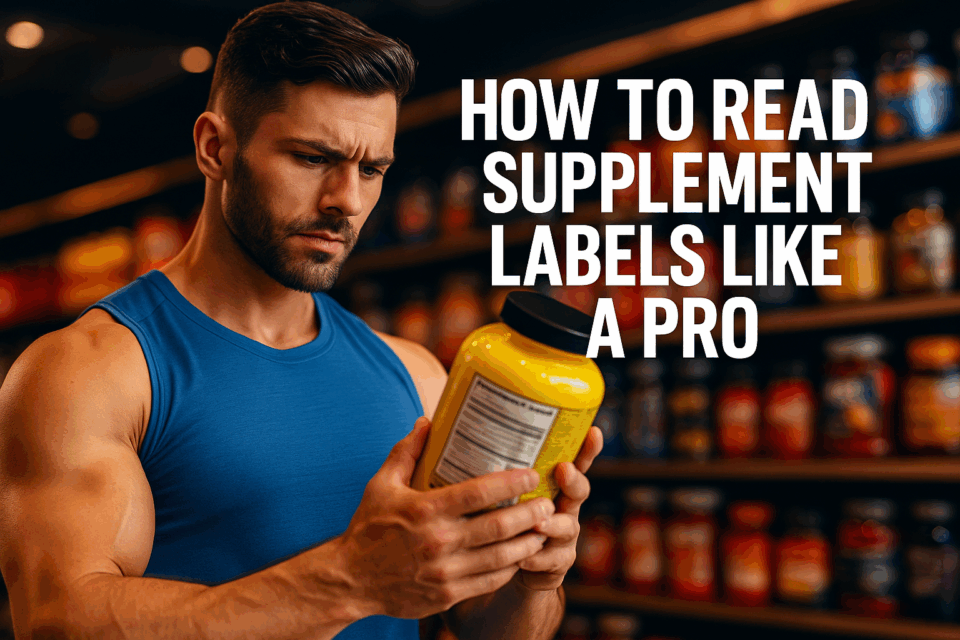If you’ve been lifting for more than five minutes, you’ve probably noticed the supplement industry is both massive and… a little shady. The market is full of promising bottles and flashy marketing, but the reality is: not every product is what it claims to be. And if you’re serious about bodybuilding—especially if you’re stacking advanced supplements, SARMs, peptides, or even considering gear—you must know how to decode what’s on that label.
In the same way you wouldn’t run a complex cycle without understanding every compound, you shouldn’t put anything in your body without knowing exactly what it contains, why it’s there, and whether it’s dosed correctly.
Why Reading Supplement Labels Matters More Than Ever
The supplement industry is regulated differently from prescription drugs. In many countries, companies don’t have to prove efficacy or even test their products before selling them. That means under-dosing, filler ingredients, and misleading claims are rampant.
For serious lifters, this can mean:
-
Wasting money on ineffective formulas
-
Risking health with undisclosed or contaminated ingredients
-
Missing performance gains because of poor dosing
A pro-level understanding of supplement labels gives you the power to separate hype from science and make smarter purchases that actually support your goals.
Step 1: Check the Serving Size and Servings Per Container
Sounds basic, but this is where many companies hide the truth.
Example: a pre-workout says “Contains 3g Citrulline Malate” in big letters. But if the serving size is two scoops, and you only take one, you’re getting half the advertised dose.
Always look for:
-
Serving size – Is it realistic for how you’ll use it?
-
Servings per container – Does the price make sense when you calculate cost per serving?
Pro tip: Bodybuilders who track cost per effective dose save hundreds of dollars per year by spotting label tricks like this.
Step 2: Understand the “Supplement Facts” vs. “Other Ingredients”
The “Supplement Facts” panel lists the active ingredients—the compounds intended to produce results. “Other Ingredients” are usually fillers, binders, flavorings, and colors.
Watch for:
-
Hidden sugars or carbs in protein powders or aminos
-
Artificial dyes like Red 40 or Yellow 5 if you avoid synthetic colorants
-
Artificial sweeteners—not necessarily bad, but worth knowing
For peptide or SARM blends sold as “research chemicals,” this section often reveals stabilizers or carriers that can affect bioavailability.
Step 3: Spotting Proprietary Blends
This is where brands combine multiple ingredients into one listing without telling you the exact amount of each.
Example:
“Muscle Pump Matrix – 5,000 mg”
Contains: L-Citrulline, Agmatine Sulfate, Beta-Alanine, Glycerol Monostearate
The problem? You have no idea if you’re getting 4g Citrulline and 1g of everything else… or 0.5g Citrulline and mostly filler.
Rule of thumb for pros: Avoid proprietary blends unless you trust the brand completely or the dosing is still clear from research and label transparency.
Step 4: Know the Clinical Dosages
Labels mean nothing if you don’t know the science behind the doses. Many companies use “pixie dusting”—adding just enough of an ingredient so they can list it, but far below the dose proven to be effective.
Examples:
-
Creatine Monohydrate – Effective at 3–5g/day
-
Beta-Alanine – Effective at 3.2–6.4g/day (but may cause paresthesia at higher doses)
-
Citrulline Malate – Effective at 6–8g pre-workout
If the label shows half the recommended dose, you’re paying for underperformance.
Step 5: Check the Form of the Ingredient
Not all forms are equal. For example:
-
Magnesium oxide (cheap, poor absorption) vs. magnesium glycinate (better bioavailability)
-
Creatine monohydrate (proven) vs. exotic creatine forms with little research
-
L-carnitine L-tartrate (great for recovery) vs. acetyl-L-carnitine (better for cognitive focus)
High-quality forms cost more but usually deliver better results.
Step 6: Verify Third-Party Testing
This is critical for SARMs, peptides, and sports supplements. Look for:
-
NSF Certified for Sport
-
Informed-Choice/Informed-Sport
-
Lab door or other independent lab tests
With peptides, check for HPLC purity reports—and cross-verify batch numbers.
Step 7: Expiration Date and Storage Info
Many compounds degrade over time, especially:
-
Peptides (should be stored refrigerated after reconstitution)
-
Omega-3s and oils (go rancid if not stored properly)
-
Certain vitamins (like Vitamin C) lose potency quickly
Step 8: Match the Label to Your Goals
Every supplement should match your training phase:
-
Bulking – Creatine, carb powders, SARMs/peptides for anabolism
-
Cutting – Thermogenics, fat loss peptides, nutrient partitioners
-
Recomp – Glucose disposal agents, moderate-dose SARMs, performance aminos
If the label doesn’t directly serve your cycle’s purpose, it’s just noise.
Bottom Line for Pros
Reading a label like a pro is about control—control over your performance, your money, and your health. Every scoop, every capsule, every injection should be intentional. The supplement industry will keep using hype to sell, but if you can cut through the marketing with an analytical eye, you’ll be ahead of 90% of lifters out there.
Final Takeaway: A serious athlete’s supplement shelf should be the result of strategy, not impulse buys. Treat labels like you treat your training log—data that determines results.




